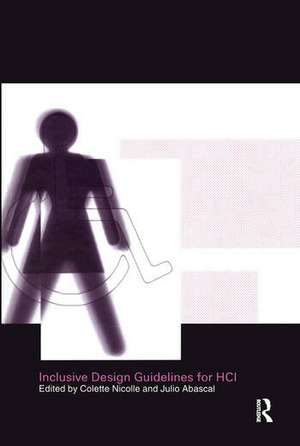Inclusive Design Guidelines for HCI
Autor Collette Nicolle, Julio Abascalen Limba Engleză Hardback – 28 iun 2001
This book will help designers world-wide find relevant guidelines for the design of human-computer interaction and ensure that systems are designed for all, with specific consideration of people who are elderly and people with disabilities.
Including reports from the International Federation of Information Processing's Working Group on Human-Computer Interaction (HCI) and Disability. The book will be the first compendium of guidelines.
Preț: 1240.47 lei
Preț vechi: 1669.79 lei
-26% Nou
Puncte Express: 1861
Preț estimativ în valută:
237.39€ • 247.53$ • 197.29£
237.39€ • 247.53$ • 197.29£
Comandă specială
Livrare economică 27 februarie-13 martie
Doresc să fiu notificat când acest titlu va fi disponibil:
Se trimite...
Preluare comenzi: 021 569.72.76
Specificații
ISBN-13: 9780748409488
ISBN-10: 0748409483
Pagini: 304
Ilustrații: 30 tables, 30 line drawings, 15 b&w photographs
Dimensiuni: 156 x 234 x 20 mm
Greutate: 0.63 kg
Ediția:1
Editura: CRC Press
Colecția CRC Press
ISBN-10: 0748409483
Pagini: 304
Ilustrații: 30 tables, 30 line drawings, 15 b&w photographs
Dimensiuni: 156 x 234 x 20 mm
Greutate: 0.63 kg
Ediția:1
Editura: CRC Press
Colecția CRC Press
Public țintă
ProfessionalCuprins
Part I: Introduction 1. Why Inclusive Design Guidelines? Part II: General Issues in the Design Process 2. Training, Verification and Evaluation of Guidelines 3. Accessibility and Usability Requirements for ITCs for Disabled and Elderly People: A Functional Classification Approach 4. On the Validity of Design Guidelines and the Role of Standardisation 5. Markets and Regulations Part III: Tools for Accessing and Using Guidelines 6. Managing Accessibilty Guidelines During User Interface Design 7. Managing HCI Guidelines with Hypertext on the WWW 8. Bobby: A Validation Tool for Disability Access on the WWW Part 4: Existing Guidelines 9. Nordic Guidlines for Computer Accessibility 10. Guidelines for Web Accessibility 11. Userfit: User Centred Design in Assistive Technology 12. The ISO Approach to the Development of Ergonomics Standards for Accessibility Part 5: Guidelines for Specific Application Areas 13. Guidelines for Telecommunications 14. Public Access Terminals 15. Accessible Systems for Transport 16. Guidelines for the Development of Home Automation Products 17. User Friendly Software for Computer-Based Instruction and Learning Materials Part 6: The Future 18. Telecommunications- Accessibility and Future Directions
Notă biografică
Collette Nicolle, Julio Abascal
Descriere
The elderly population is growing and disabilities tend to increase with age. Professionals in the field of human-computer interaction (HCI) are becoming increasingly aware of the needs of the elderly and people with disabilities. They also need to ensure that systems are designed for all, with specific consideration of these groups, not only computing systems but also other assistive and adaptive technologies such as information services and the use of smart cards, assistive robotics, systems for travellers, and home and environmental control systems. Designers need to monitor the latest developments in the design of HCI and to appreciate their impact on accessibility and usability.
